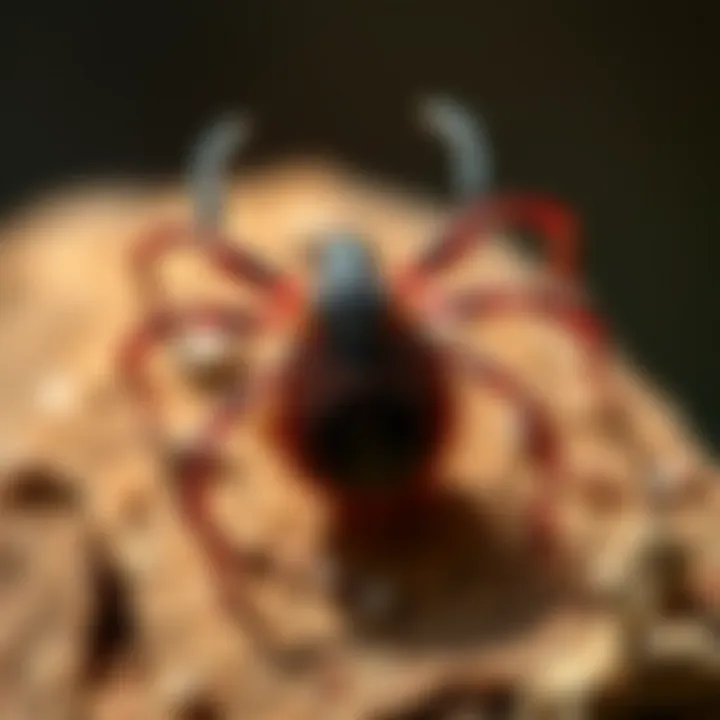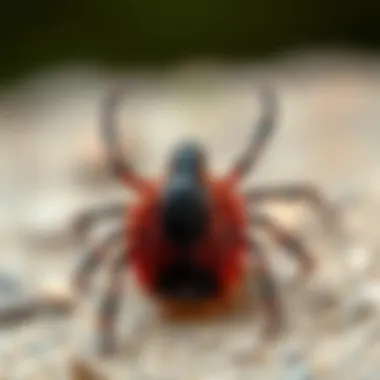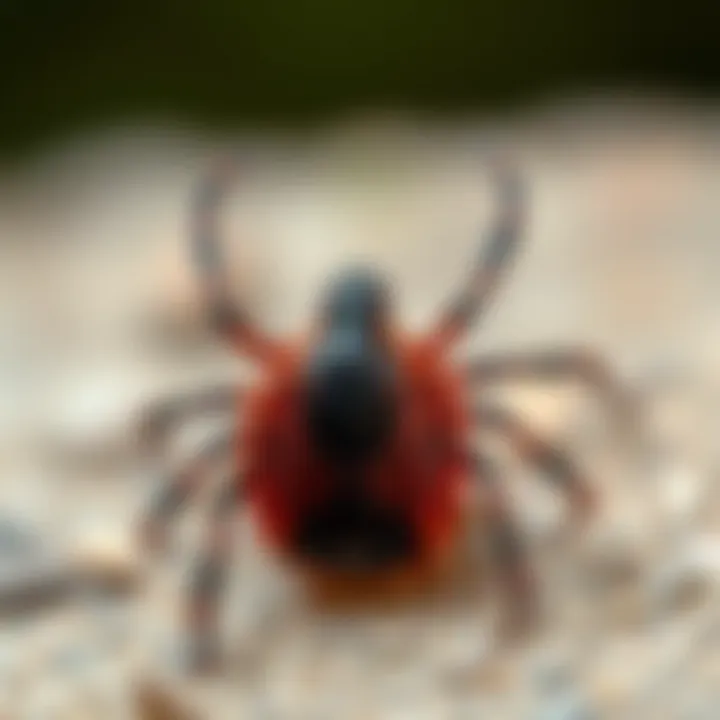Effective Strategies for Managing Yard Ticks Safely


Intro
Ticks can be a significant concern for homeowners, especially in regions where these tiny pests thrive. Their presence doesn't just pose a nuisance; they can carry serious diseases that affect both humans and pets. Understanding the biology and behavior of these creatures is essential in developing effective treatment strategies. In this article, we will delve deeply into the various methods for treating ticks in your yard, focusing on a balanced approach that considers both chemical and organic solutions.
Understanding Pests
Definition of Pests
In the world of gardening and yard maintenance, the term "pests" typically refers to organisms that disrupt the balance of your outdoor space. Although many might think of pests chiefly as insects, this group also includes arachnids like ticks. These tiny arachnids are not just bothersome; they are vectors for various diseases, making proper identification and management vital to maintaining a healthy environment.
Importance of Pest Identification
Identifying ticks is not merely about knowing they exist. It's imperative to understand the specific species present in your yard, as this can dictate not only the treatment options available, but also the timing and methods you'll employ. For instance, the blacklegged tick, also known as the deer tick, is a common carrier of Lyme disease. Meanwhile, other species like the American dog tick are known for transmitting different illnesses. Knowing your enemy helps you strategize effectively.
Prevention Techniques
Home and Garden Preventative Measures
Prevention is the most effective strategy when it comes to managing ticks. Start by creating a barrier in your garden using wood chips or gravel, as this can deter ticks from getting too close to your home. Regularly maintaining your lawn by mowing it short and removing tall grasses and dense brush can significantly reduce their habitat.
Here are some additional measures:
- Seal gaps in your home's foundation and around windows and doors to prevent ticks from seeking shelter within.
- Use repellents—a variety of natural sprays are available that can deter ticks from your skin and clothing when you're out in the yard.
Seasonal Prevention Tips
Different seasons come with their unique challenges. Spring and early summer often bring an uptick in tick activity. During these times, staying vigilant is crucial. Consider the following tips:
- Check your pets regularly for ticks after they have been outdoors. Pets are often the first to carry them into your living space.
- Reduce yard clutter; piles of leaves or unused equipment can provide excellent hiding spaces for ticks, making your outdoor area a breeding ground.
Eco-Friendly Pest Control Solutions
Overview of Sustainable Practices
Sustainability is more than a buzzword; it is a cornerstone for effective pest management that is gentle on the environment. Utilizing eco-friendly treatments can often yield substantial results while mitigating adverse effects on beneficial insects and local wildlife. For instance, utilizing integrated pest management (IPM) strategies allows you to combine multiple approaches for effective tick control.
Natural Remedies and Their Effectiveness
Many homeowners are gravitating toward natural remedies for pest control. Here are a couple of effective options:
- Essential oils such as cedarwood or lavender can repel ticks. When mixed with a carrier oil or water, they can be applied to clothing or yard areas as a natural deterrent.
- Diatomaceous earth, a natural powder made from fossilized algae, can be sprinkled in yard areas prone to tick infestations. It works by desiccating pests upon contact.
"An ounce of prevention is worth a pound of cure." This saying rings particularly true in the case of tick management.
By adopting these eco-friendly practices, you can regain control over your yard while minimizing your environmental footprint. For more information on sustainable gardening practices, resources like Wikipedia and Britannica may prove helpful.
With our deep dive into understanding pests and prevention strategies, we set a solid framework for addressing the critical issue of ticks in your yard. Next, we will detail the various treatment applications available for tick control.
Understanding Ticks
Understanding ticks is the foundation upon which effective yard tick management rests. Identifying the biology and behavior of these pests enables homeowners to devise strategies that lessen the risks associated with infestations. When you know how ticks live, reproduce, and thrive, you can better plan and implement preventive and treatment measures. This information not only empowers homeowners but also raises awareness of the potential health hazards brought on by these creatures.
The Biology of Ticks
Lifecycle of Ticks
Ticks have a complex lifecycle comprising four distinct stages: egg, larva, nymph, and adult. The journey begins when a female tick lays thousands of eggs on the ground. Upon hatching, the larvae seek a tiny host—think small mammals or birds. Once fed, they drop off, molting into nymphs. This stage is significant because nymphs tend to be more active and can easily infest areas frequented by humans and pets. After a final meal, they mature into adults, laying the groundwork for future generations. What makes their lifecycle particularly fascinating is the endurance of ticks; they can survive long periods without a meal, giving them a robust edge in various environments. This is essential knowledge when assessing how to control tick populations effectively in your yard.
Common Species Found in Yards
Several tick species commonly inhabit yards, each presenting unique challenges. The black-legged tick, known for spreading Lyme disease, is most prevalent in wooded and grassy areas. Another tough competitor is the American dog tick, notorious for transmitting rocky mountain spotted fever. Recognizing these common species is vital, as each has specific behaviors and habitats that dictate control methods. For instance, while the American dog tick prefers open fields, the black-legged tick thrives in shaded locations. By understanding where these ticks are likely to congregate, homeowners can take targeted actions to limit exposure and manage populations effectively.
Behavioral Patterns
Ticks exhibit fascinating behavioral patterns which are crucial for their survival. They tend to remain inactive until a host passes by, using a technique called questing. During this act, they extend their front legs and wait for a host to brush past, allowing them to latch on. This behavior underscores the importance of keeping grass trimmed and reduces clutter in your yard where ticks could hide. Another pattern worth noting is their preference for humid environments, which allows them to survive longer periods without water. Understanding these patterns not only aids in developing prevention strategies but also informs the timing of any treatments applied.
Health Risks Associated with Ticks
Tick-Borne Diseases
Ticks are vectors for several tick-borne diseases that pose serious health risks to both humans and pets. The bacterium Borrelia burgdorferi, responsible for Lyme disease, is the most notorious among many. Other common ailments include babesiosis and anaplasmosis. These diseases can lead to various symptoms ranging from mild to debilitating ones. Knowledge of the diseases that ticks carry is crucial for homeowners, as it emphasizes the significance of prompt intervention and treatment. Recognizing the potential for such illnesses makes proactive yard management an essential priority.
Symptoms of Tick Bites
Detecting symptoms of tick bites is key for early intervention. Common indicators include red, itchy rashes that may develop around the bite site. As the bite progresses, some individuals might experience flu-like symptoms such as fever, fatigue, or muscle aches. Notably, these symptoms can appear days or even weeks after the initial bite, leading to delayed diagnoses of tick-borne diseases. Prompt recognition of these symptoms allows for quicker treatment and can significantly impact recovery and health outcomes.


Long-Term Effects
In some cases, untreated tick-borne diseases can result in long-term health complications. For instance, Lyme disease can cause joint pain and neurological issues if not treated early. This underscores the importance of vigilance; by understanding the ongoing risks associated with tick bites, homeowners can appreciate why control measures and effective treatments are vital for safeguarding their family and pets. The serious implications of tick exposure make it even more essential to equip oneself with knowledge and preventive strategies.
Signs of Tick Infestation
Recognizing the signs of tick infestation is crucial for any homeowner, as it sets the stage for effective management of these pests. Early detection not only minimizes the risk of tick-borne diseases but also helps in maintaining a healthier environment. Understanding tick presence involves more than just spotting one; it requires a keen awareness of their habitat and behavior. This section will delve into the different ways to identify ticks in your yard, from visual inspections to understanding common hiding spots.
Identifying Ticks in Your Yard
Visual Inspections
Visual inspections are a primary method for identifying ticks in your yard. This proactive approach involves conducting thorough checks in high-risk areas such as tall grass and shrubbery after outdoor activities. Homeowners should be attentive to the darker color of ticks against lighter backgrounds, often making them easier to spot.
What marks visual inspections as a solid choice is its accessibility; no specialized equipment is needed, just keen eyesight and a little bit of patience. This method works best during warmer weather when ticks are most active. However, one downside is that small ticks can be quite challenging to see, especially in densely vegetated areas.
Common Hiding Spots
Ticks have specific areas they prefer, and knowing these common hiding spots can greatly enhance your chances of finding them. They tend to lurk in tall grasses, leaf litter, and shaded areas under dense shrubs, often waiting for a host. Understanding this behavior can guide you in making your outdoor space less inviting for ticks.
A key aspect of these hiding spots is their strategic selection; they provide both moisture and protection from the heat, making them ideal for ticks. Nonetheless, while it’s informative to know where ticks tend to hide, it presents a disadvantage if homeowners do not feel comfortable clearing these areas regularly.
Evidence of Tick Activity
Evidence of tick activity can manifest in various forms. Homeowners may notice signs like tick bites on pets or family members, or find fallen ticks in areas where animals frequent. Additionally, another indicator can be the presence of shed tick bodies after molting. Being able to recognize these signs is crucial for assessing the level of infestation.
The importance of keeping an eye on such evidence lies in its ability to help estimate the infestation's severity, allowing for timely interventions. One drawback, however, is that not all tick bites lead to noticeable reactions, especially in individuals who may not be sensitive to bites. Thus, maintaining awareness is essential, as relying solely on visible evidence may lead one to underestimate the presence of ticks.
Assessing Tick Populations
Once signs of tick activity have been identified, the next logical step is assessing the population density of ticks within your yard. Understanding how many ticks you're dealing with helps inform your treatment choices, ensuring they are both effective and proportional to the problem at hand.
Tick Counts and Surveys
Conducting tick counts and surveys can provide invaluable insights into the tick population. Simple surveys can involve walking through your yard and checking for ticks on clothing or skin while taking notes on locations. This method is straightforward and allows homeowners to gather information on potential hotspots.
A big advantage of the count-survey method is its ability to offer real-time feedback on tick presence. However, one limitation could be the variability in tick populations, which may fluctuate based on seasonal changes or environmental factors. Thus, surveying may need to occur at various times to get an accurate picture.
Using Tick Detection Tools
For those looking to take a more scientific approach, using tick detection tools can be an excellent way to gauge tick populations. Traps designed specifically to monitor ticks can be effective at collecting samples over time. These tools can provide key data that can inform subsequent treatments and preventive measures.
The unique feature of tick detection tools is they can serve as a passive method of monitoring, requiring less active involvement from homeowners. Still, potential disadvantages include the cost of acquiring such tools and the need for some degree of technical know-how to interpret the data.
Documenting Findings
Lastly, documenting findings from your inspections and assessments enhances your ability to track tick populations over time. Keeping records can help homeowners understand patterns, making it easier to adjust treatments accordingly. You might consider using a simple logbook or digital app to keep track of tick presence and conditions in your yard.
The key characteristic of documenting findings is its capacity for providing a clear history of tick activity over time, which can be incredibly useful in long-term management. On the flip side, regular documentation may require dedication and time, which can be a hurdle for busy individuals.
"Regular monitoring and assessment can keep your yard tick-free and your family safe."
By utilizing these various strategies for identifying ticks and assessing their populations, homeowners can significantly improve their understanding of tick behavior, leading to better management of these pests.
Preventive Strategies
When it comes to combatting tick infestations in your yard, preventive strategies serve as your first line of defense. Rather than waiting for an infestation to develop, taking preemptive action helps in reducing tick populations and shielding your family from tick-related health risks. These methods are crucial not only for immediate precautions but also for the long-term health of your outdoor space. Combining effective yard maintenance techniques with landscaping strategies can create an environment that naturally deters ticks.
Landscaping Techniques
Choosing Tick-Repelling Plants
Selecting the right plants can be a game changer in your yard. Tick-repelling plants have properties that make them unappealing to these pests, providing a natural way to safeguard your garden. Examples include lavender and marigolds. These plants are attractive choices because they add beauty while serving a purpose.
The key characteristic of these plants is their strong fragrances, which discourage ticks. Notably, lavender is not only pleasing to the human nose but also acts as a natural insect repellant. However, while incorporating tick-repelling plants into your landscaping can be effective, it’s essential to remember that these plants work best as part of a broader strategy rather than a standalone solution.
Creating Barrier Zones
Another effective technique is establishing barrier zones, which can significantly lower the risk of ticks entering play areas or gardens. Barrier zones typically involve using gravel or wood chips to create a physical boundary between wooded areas and more frequented regions of your yard. This method includes a multi-layered approach—setting up these zones can limit ticks from wandering into your lawn and provide a designated area for safe play.
A unique feature of barrier zones is their capacity to break the life cycle of ticks. Unfortunately, homeowners may overlook this simple yet powerful tactic, perhaps due to underestimating weeds or ticks as real threats. By effectively delineating space, you not only reduce the chances of a tick encounter but also promote organized, functional landscaping.
Maintaining Open Spaces
The final piece of the landscaping puzzle is maintaining open spaces. Having clear, open areas in your yard allows for better sunlight penetration, which is an enemy to tick population growth. Dense foliage can create ideal tick habitats, so trimming back bushes and keeping lawns neatly mowed create an inhospitable environment for ticks.
The benefit of open spaces is that they serve not just as a deterrent to tick habitation, but they also provide safer zones for family activities. However, it’s vital to monitor these areas consistently, as unmanaged open spaces can quickly revert back to wooded conditions, conducive for tick proliferation.


Yard Maintenance Practices
Regular Mowing and Grooming
Keeping your yard tidy through regular mowing and grooming is critical. When grass is kept short, it reduces tick hiding spots, making it harder for them to thrive. Frequent maintenance not only keeps ticks at bay but also enhances the aesthetic of your property.
Another essential aspect is the manicuring of edges and pathways. If left unkempt, these areas can easily turn into tick sanctuaries. However, over-mowing can reduce habitat diversity, which could impact other beneficial insects. Thus, finding a balance is key for both tick management and ecosystem health.
Managing Leaf Litter and Debris
Ticks love moisture, and piles of leaves or debris can serve as the perfect nest for them. Managing leaf litter is critical, especially in the fall. Regularly raking leaves not only removes potential ticks but also decreases moisture that may beckon them.
A unique feature of managing debris is that it encourages cleaner gardens. It promotes not just tick control but also general yard health. On the downside, too much exposure to yard elements, like direct sunlight or wind, might inadvertently harm other garden plants if they rely on leaf cover. Hence, adopt a systematic approach to yield benefits without drawbacks.
Minimizing Clutter
In addition to maintaining foliage and managing debris, it’s important to minimize clutter in your yard. Items like old furniture, piles of wood or yard equipment can create dark, damp places for ticks to multiply. Regularly going through and decluttering these areas can significantly reduce tick habitats.
This practice allows for better visibility and control of the space around your home. However, homeowners must be careful not to dispose of items that could otherwise serve beneficial roles within the garden ecosystem. Therefore, identifying what to keep and what to toss can require critical judgment, but the rewards of an organized yard are undeniable.
Chemical Treatments
When it comes to tackling tick infestations in your yard, chemical treatments can play a pivotal role. These methods offer homeowners viable options for reducing tick populations, especially when dealing with severe infestations. Their benefits include quick action and prolonged effectiveness, making them appealing for those needing immediate results. However, safety considerations must be front and center when employing these treatments, as they can have far-reaching implications.
Types of Pesticides
Synthetic Chemicals
Synthetic chemicals are often the go-to choice for many homeowners waging war on ticks. These pesticides tend to have powerful formulae designed specifically for tackling complex pest problems. A key characteristic of synthetic chemicals is their ability to penetrate tick biology, disrupting their lifecycle effectively. This direct approach renders these chemicals popular due to their fast-acting nature.
However, there's a flip side. The unique feature of synthetic chemicals lies in their potential to harm non-target species, including beneficial insects. Additionally, over-reliance can lead to resistances, making it a high-stakes game if not managed responsibly. Hence, caution is the name of the game with this approach.
Natural Pesticides
Natural pesticides present a more environmentally friendly alternative that’s gaining traction in recent times. These products are derived from plant extracts or other natural sources, which means they often pose a reduced risk to non-target wildlife. The standout trait of natural pesticides is their biodegradable nature, which can resonate well with environmentally-conscious homeowners.
Yet, users may note that while they are less harmful to the ecosystem, natural pesticides often require more frequent application to maintain effectiveness. Their dependency-oriented nature can be cumbersome, leading some to stick to synthetic alternatives out of sheer convenience, even when they have reservations about their environmental impact.
Application Methods
The effectiveness of any chemical treatment hinges significantly on the application methods employed. Proper application techniques can maximize the efficacy of the chosen pesticide, enhancing the overall impact. Methods such as spraying, granular distribution, or even fogging are commonly used to ensure comprehensive coverage of affected areas. A prime characteristic here is precision; measured applications help in reaching areas where ticks are likely to congregate.
However, it's important to recognize that improper application can lead to residues on plants and soil, raising safety flags for families and pets. Over-applied products can contaminate surrounding areas, creating a ripple effect on the ecosystem. Therefore, understanding how to apply effectively while minimizing risk is crucial for any homeowner opting for chemical treatments.
Safety Considerations
Protective Gear for Application
Using protective gear when applying pesticides cannot be overstated. This step ensures that the person handling the chemicals remains safe from any harmful exposure. The essential characteristic of protective gear is its ability to form a barrier against skin contact and inhalation, protecting both the user and their family.
A unique feature of proper gear involves using gloves, masks, and sometimes even safety goggles. Ignoring this can lead to health complications over time, which is a risk that becomes hard to justify when alternatives exist. Thus, having the right gear is a crucial part of minimizing exposure.
Impact on Non-Target Species
The consequences of chemical treatments often extend beyond just ticks. One of the significant risks of using synthetic and, to a lesser extent, even natural pesticides is their potential impact on non-target species. These chemicals can unintentionally harm beneficial insects, like bees and butterflies, posing threats to pollination and biodiversity.
The challenge here is balancing effectiveness against ecological harm. While some homeowners opt for chemicals for quick results, they might inadvertently place their local ecosystem in jeopardy. Informed choices and careful consideration of the broader environmental effects become essential in this context.
Safe Usage Guidelines
Following safe usage guidelines while dealing with chemical treatments cannot be overlooked. Proper regulations help mitigate risks associated with chemical exposures. These guidelines typically cover aspects such as application timing, safe distances for pets and children, and specific measurements for usage.
A unique feature of these guidelines is their adaptability; they can be tailored depending on the specific product and the yard conditions. Ignoring these protocols could result in less effective treatments, alongside potential health hazards. By adhering to these recommendations, users can achieve a balance between effective tick control and community safety, maintaining a healthy yard for everyone involved.
"Safety is not just a priority; it's a practice that demands diligence."
In summary, chemical treatments are a powerful tool in the fight against ticks, but they come with caveats. Homeowners need to weigh their options carefully and remain attentive to the potential consequences while employing these methods. By being well-informed and cautious, it is possible to manage tick populations effectively while fostering a safe and vibrant outdoor environment.
Organic Treatment Methods
In recent years, organic treatment methods have gained traction among homeowners looking for sustainable ways to manage tick populations in their yards. The climb in popularity stems from a growing awareness of environmental concerns as well as the potential health risks of chemical pesticides. Organic methods not only aim to control ticks but also to promote a healthy ecosystem, making them an appealing choice in the quest for an effective, safe approach to yard maintenance.
Natural Repellents
Essential Oils
Essential oils are derived from plants, and they offer a natural way to ward off ticks. These concentrated extracts carry a variety of compounds that insects find unpleasant, effectively working as deterrents. In the context of managing ticks, oils like lavender, eucalyptus, and citronella stand out due to their known repellent properties.


One key characteristic of essential oils is their pleasant fragrance for humans, but strong scent for pests. This dual nature makes them particularly appealing for gardeners who desire a fragrant, yet functional yard. However, when using these oils, a level of caution is necessary. Essential oils require dilution before application to avoid skin irritation, and they may need frequent reapplication, especially after rain.
Homemade Sprays
Creating homemade sprays is another easy method to use in tick control. These sprays can be formulated with common household ingredients, making them affordable and accessible. A typical recipe may blend vinegar, water, and essential oils, providing a balance of effective repellent and non-toxic formula.
The charm of homemade sprays lies in their customize-ability. Homeowners can experiment with different combinations until they find a solution that works best for their environment and needs. However, it's crucial to note that consistency in application will affect the overall efficacy. Without regular application, the protective barrier can diminish quickly, making it less effective.
Beneficial Insects
Beneficial insects play a vital role in managing tick populations organically. These are natural predators, such as certain beetles and spiders, that assist in keeping tick numbers in check. What makes them a popular choice is their ability to coexist with plants without causing harm to the ecosystem.
When encouraged, beneficial insects can bring harmony to a yard by creating a natural balance. However, homeowners must also ensure that their environment is suitable to support these insects; promoting their presence may require a shift away from synthetic treatments that could harm their populations.
Long-Term Organic Strategies
Encouraging Predators
A solid way to keep ticks at bay is to cultivate an environment that promotes natural predators. This can be achieved by planting native flora that attracts these beneficial species or creating small shelters where they can thrive.
This method is advantageous not just for ticks, but for overall yard health. Predators help maintain the balance within the garden, further diminishing pest populations over time. One disadvantage may be the time required for predators to establish a stable population; it won't happen overnight.
Healthy Ecosystem Practices
Implementing healthy ecosystem practices can drastically impact the presence of ticks and other pests. This can include methods such as crop rotation, maintaining a diverse range of plants, and composting organic waste. These practices contribute to soil health, providing a robust habitat for both plants and the insects that help protect them.
A healthy ecosystem creates a self-sustaining environment, reducing reliance on any type of treatment. Nevertheless, it can take time to develop these systems, demanding patience from homeowners.
Sustainable Gardening Techniques
Employing sustainable gardening techniques wraps up how to manage pests without causing harm to the environment. Techniques such as using mulch, creating diverse planting zones, and practicing organic fertilization contribute significantly to the overall wellbeing of a garden.
These approaches enhance biodiversity, making it harder for ticks to establish themselves while simultaneously promoting the health of the plants in the yard. For those unfamiliar with sustainable practices, it may seem daunting initially. However, the long-term benefits of resilience and health can far outweigh any initial effort.
"The best way to control pests organically is by fostering a balanced ecosystem that supports natural predators."
Through organic treatment methods, homeowners not only tackle tick infestations but also contribute positively to the environment. While every strategy has its challenges, combining different approaches can lead to a thriving yard environment that is both beautiful and functional.
For further reading on ecological gardening practices, you can visit Wikipedia or the U.S. Department of Agriculture.
Follow-Up and Maintenance
Maintaining a yard free from ticks isn't just a one-off task; it requires ongoing attention and strategy. Follow-up and maintenance play a significant role in creating a sustainable, tick-free environment. By regularly monitoring and adjusting your processes, homeowners can effectively manage tick populations and protect their loved ones. This section explores key strategies that help ensure the yard remains not just tick-resistant but also a healthy habitat for your family and pets.
Monitoring for Ticks
Setting Up Regular Inspections
Regular inspections serve as the backbone of tick management. When you establish a routine—let's say once every two weeks—you not only catch ticks early, but also keep tabs on their habits. This structured approach allows you to tweak your strategies based on what you observe. A strong point about this method is that it empowers you to take charge of your yard's health. By checking areas where ticks tend to hide, such as tall grasses and around shrubbery, you can drastically reduce the likelihood of a tick problem.
One unique feature of setting up regular inspections is how it encourages vigilance amongst family members. Make it a family activity. Children can learn to identify areas of concern while adults can handle remediation strategies. While some might say it feels like an added chore, many find it to be a worthwhile investment in safety.
Utilizing Tick Tracking Resources
Tick tracking resources are useful tools that can streamline your monitoring efforts. By using online platforms or apps designed for tracking tick populations, homeowners obtain real-time data about tick activity in their area. This information enhances your understanding of local tick behavior and can guide you on the best times for inspections or treatments.
A notable aspect of these resources is their community dimension. By sharing your findings, you contribute to a wider effort in combating tick infestations not just in your yard but potentially in the entire neighborhood. Such collaboration can foster a sense of community responsibility. However, access to these resources may vary based on location and some might find the tech requirements daunting.
Adjusting Strategies Based on Findings
After monitoring the situation, you might find that your original strategies aren't yielding the desired results. That's where adjusting your approach comes into play. It involves being flexible and responsive to new information that emerges from your inspections or tracking. If some areas still seem to attract ticks despite your best efforts, you may need to rethink your landscaping choices or treatment methods.
What's beneficial about this adaptability is that it transforms pest management into a more dynamic process. You're not just stuck with a “one-size-fits-all” plan. You can innovate with each season's findings. Intensifying a treatment or trying a new approach isn't just something you can do; it's essential for staying on top of tick populations.
Evaluating Treatment Effectiveness
Reviewing Success Metrics
It's not enough to just do; you must also measure the impact of your actions. Reviewing success metrics helps you realize if the measures you've put in place are working. This might involve tracking the number of ticks found during inspections, observing changes in tick behavior, or examining the incidence of bites within your household.
The challenge lies in defining what success means for your yard. For some, it might be a complete absence of ticks, while for others, it could mean ample reductions in tick populations. The key takeaway here is to remain realistic yet determined in your evaluations.
Reporting Changes Observed
Documenting the changes you observe can pave the way for better future decisions. By keeping a log of what's working and what isn't, you create a reference that helps inform your ongoing strategy. This practice not only clarifies your gains but also identifies persisting issues before they escalate.
An interesting characteristic of staying observant and reporting your findings is the potential it has for community engagement. Sharing your observations with neighbors can lead to collaborative efforts, enhancing everyone’s success. However, if everyone’s not on board, discrepancies in tick management may arise, creating more challenges.
Fine-Tuning Approaches
This is where the magic of refinement comes in. Fine-tuning your approaches implies a continual cycle of evaluation and adaptation. Maybe you realize that certain chemical treatments cause a decline in beneficial insects, or perhaps your landscaping isn’t as effective in keeping ticks at bay as you hoped.
The takeaway here is that every little adjustment contributes significantly towards a holistic solution. Fine-tuning digs deeper than surface fixes, probing into what's truly causing issues in your yard. Not everyone takes the time to hone in on these aspects, but those that do often find greater success in their long-term management strategies.



